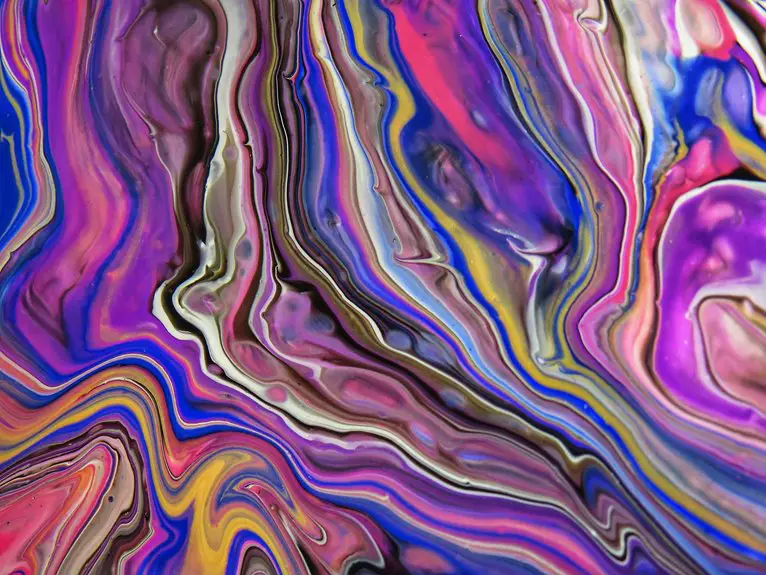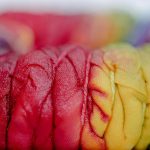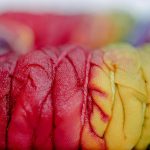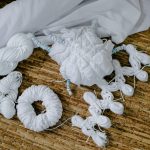You can easily create vibrant designs using cold water dyes, which bond to natural fibers like cotton without heat. Start with pre-washed, damp fabric and use tools like squeeze bottles or brushes to apply dye evenly. Keep your workspace protected and wear gloves to stay clean. After dyeing, rinse in cold water and air dry away from direct sun to preserve colors. With the right fabric and technique, your projects will shine—explore further to reveal advanced tips and tricks.
Table of Contents
Key Takeaways
- Cold water dyes bond chemically with natural fibers at room temperature, eliminating the need for heat during dyeing.
- Pre-wash natural, untreated fabrics like cotton or silk to remove residues and improve dye absorption and color vibrancy.
- Use protective gloves, spray or squeeze bottles, and prepare dye mixtures in a covered workspace for controlled application.
- Apply dye gently on damp fabric starting with lighter shades, then rinse in cold water until clear before drying.
- Enhance color fastness by maintaining alkaline pH with soda ash and drying dyed items in shaded, ventilated areas.
Understanding the Science Behind Cold Water Dyes
Although cold water dyes may seem simple, they rely on a complex chemical process that you should understand to get the best results.
These dyes contain fiber-reactive agents that bond with fabric fibers at room temperature, unlike traditional dyes needing heat. When you apply cold water dye, the reactive groups form strong covalent bonds with the hydroxyl or amino groups in the fibers, ensuring vibrant, long-lasting color.
You’ll want to keep the fabric wet and maintain an alkaline pH, usually by adding soda ash, to help this reaction along. Understanding this chemistry allows you to manipulate color intensity and fastness effectively.
Choosing the Right Fabrics for Cold Water Dyeing
Selecting the right fabric is essential when working with cold water dyes because not all materials react the same way.
Natural fibers like cotton, silk, and wool absorb cold water dyes beautifully, giving you vibrant, lasting colors. Synthetic fabrics, such as polyester or nylon, don’t take the dye well and often result in dull or uneven shades.
When you choose your fabric, look for one that’s untreated and free from finishes or coatings, as these can block dye absorption. Pre-washing your fabric removes sizing or dirt, ensuring the dye bonds properly.
If you want crisp, clear patterns, opt for tightly woven fabrics, while looser weaves give a softer, blended effect.
Essential Tools and Materials for Dye Painting
Once you’ve picked the perfect fabric, gathering the right tools and materials will help you bring your dye painting to life.
You’ll want to be prepared with essentials that make the process smooth and enjoyable. Here’s what you should have on hand:
- Cold water fiber reactive dyes in various colors
- Squeeze bottles or spray bottles for precise application
- Protective gloves to keep your hands clean
- Plastic-covered workspace or drop cloth to protect surfaces
- Containers or bowls for mixing dye solutions
These items guarantee you can mix, apply, and control your dye with ease while protecting your workspace and yourself.
Having these ready sets you up for a creative and successful dye painting experience.
Step-by-Step Cold Water Dye Painting Techniques
Before you start applying dye, prepare your fabric by dampening it evenly; this helps the colors absorb smoothly and blend beautifully.
Next, set up your workspace with all materials within reach.
Begin by mixing your cold water dyes according to the instructions, keeping your colors vibrant but not too watery.
Use a brush or sponge to apply the dye gently, starting with lighter shades. Gradually add darker tones or details, layering carefully to avoid over-saturating the fabric.
Work quickly but precisely, as cold water dyes dry fast.
Once your design is complete, let the fabric air dry flat to prevent color spreading.
Finally, rinse the fabric in cold water until the water runs clear, then hang it to dry fully before use or further treatment.
Tips for Enhancing Color Vibrancy and Longevity
Although cold water dyes offer vibrant colors, you can boost their intensity and durability by taking a few extra steps. To make your dye projects pop and last longer, focus on proper preparation and care.
Here are some tips you’ll find handy:
- Pre-wash your fabric to remove any sizing or residues.
- Use a fixative or mordant suited for cold water dyes to lock in color.
- Apply dye evenly and avoid over-saturating to prevent blotching.
- Let your piece dry in a shaded, well-ventilated area to maintain brightness.
- Wash dyed items gently in cold water with mild detergent to preserve hues.
Frequently Asked Questions
Can Cold Water Dyes Be Used on Non-Fabric Materials?
You can’t effectively use cold water dyes on non-fabric materials because they’re designed to bond with fibers. Instead, try paints or dyes made specifically for surfaces like wood, plastic, or metal for better results and durability.
How Do Cold Water Dyes Compare Environmentally to Hot Water Dyes?
Imagine you’re dyeing fabric using cold water dyes; you’ll use less energy since you don’t heat water, making it more eco-friendly than hot water dyes. This saves resources and reduces your carbon footprint considerably.
Are There Any Safety Precautions for Children Using Cold Water Dyes?
You should always supervise children using cold water dyes, guarantee they wear gloves, avoid ingestion, and work in a well-ventilated area. Keep dyes away from eyes and wash hands thoroughly after use to stay safe.
Can Cold Water Dyeing Be Combined With Other Dyeing Methods?
About 70% of fabric artists combine dyeing methods. You can definitely mix cold water dyeing with techniques like tie-dye or batik. Just test colors first, so you don’t end up with unexpected blends or stains.
What Are the Best Storage Practices for Unused Cold Water Dyes?
You should store unused cold water dyes in a cool, dry place away from direct sunlight. Keep them sealed tightly to prevent moisture and contamination, ensuring they last longer and maintain their vibrant coloring power.
- How Dyes Are Used to Increase Contrast in Microscopy - July 13, 2025
- The Role of Coomassie Blue Dye in SDS-PAGE Technique - July 13, 2025
- Which Dye Is Used in the Acid-Fast Staining Technique? - July 13, 2025






